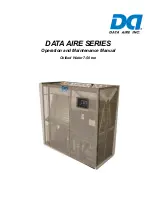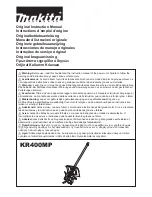
RTWB-SVN01B-E4
25
Installation Electrical
Isolated 4-20 mA current source
input
Set dip switch SW1-1 of the option
module A9 to “ON.“ Connect the
current source terminals 4 (+) and
5 (-). CWS is now based on the
following equation:
Setpoint (°C) = (mA * 2.44) - 27.56
External current limit setpoint:
voltage source 2-10 V (dc)or current
source 4-20 mA.
This option allows the external
setting of the current limit setpoint,
independent of the front panel
current-limit setpoint, by one of the
two means:
1 - an isolated voltage input 2-10 V
(dc)
2 - an isolated voltage input 4-20 mA
To enable external current-limit
setpoint operation, external current-
limit setpoint (operator setting
menu) should be set to “E“ using
the clear language display.
1- 2-10 V (dc) voltage source input
Set dip switch SW1-2 of the option
module A9 to “OFF.“ Connect the
voltage source to terminals 7 (+) and
8 (-) of the option module A9. CLS is
now based on the following
equation:
CL Setpoint % = (V (dc)*10) + 20
Sample values for CLS vs. V
(dc)signals are shown in Table 9.
Minimum setpoint : 40% (2.0 V
(dc)input)
Maximum setpoint : 120% (10.0 V
(dc)input)
4-20 mA Current source input
Set dip switch SW1-2 of the option
module A9 to “ON.“ Connect the
current source to terminal 7 (+) and
8 (-) of option module A9. CLS is
now based on the following
equation:
CL Setpoint % = (mA * 5) + 20
Sample values for CLS vs mA
signals are shown in Table 9.
Minimum setpoint = 40% (4.0 mA)
Maximum setpoint = 120%
(20.0 mA)
Table 11: Input values vs. external current-limit setpoint
Voltage (V (dc))
Current (mA)
Resulting current-limit setpoint (% RLA)
2.0
4.0
40
3.0
6.0
50
4.0
8.0
60
5.0
10.0
70
6.0
12.0
80
7.0
14.0
90
8.0
16.0
100
9.0
18.0
110
10.0
20.0
120
Outdoor air-temperature sensor
This sensor is used for low ambient
lockout and chilled-water reset by
outdoor air temperature. This sensor
is optional on the RTWB units.
Remove the sensor from its
shipping location in the control
panel and install it in the fresh-air
intake on the north wall of the
building. Protect the sensor from
direct sunlight and shelter it from
the elements.
Connect leads to terminals 1 and 2
from module A9 TB1. All wiring to
and from the remote sensor must be
made with shielded, twisted-pair
conductors. Be sure to ground the
shielding only at the UCM. Apply
tape to the sensor end of the
shielding to prevent it from
contacting the surface.
W
WA
AR
RN
NIIN
NG
G
To prevent injury or death,
disconnect the electrical power
source before completing wiring
connections to the unit.
C
CA
AU
UT
TIIO
ON
N
To prevent overheating at the
terminal connections, use copper
conductors only.
Communication card
This option allows the Clear
Language Display in the control
panel on RTWB units to exchange
information (operating setpoints and
Auto/Standby commands) with a
higher-level control device, such as
Tracer. A shielded, twisted-pair
connection establishes the
bidirectional communications link
between the unit control panel and
the Tracer.
C
CA
AU
UT
TIIO
ON
N
Note: The shielded, twisted-pair
conductors must run in a separate
conduit.
C
CA
AU
UT
TIIO
ON
N
To prevent control malfunction, do
not run low-voltage wiring (<30V) in
conduits with conductors carrying
more than 30 volts.
















































